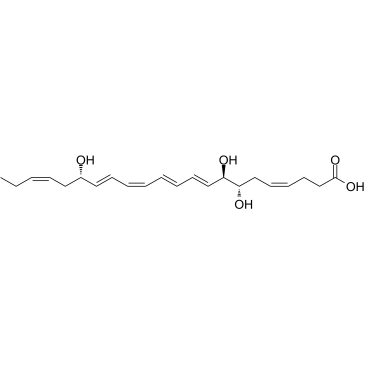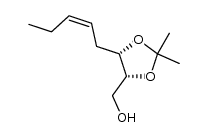Resolvin D1
Modify Date: 2025-08-27 13:40:48

Resolvin D1 structure
|
Common Name | Resolvin D1 | ||
|---|---|---|---|---|
| CAS Number | 872993-05-0 | Molecular Weight | 376.487 | |
| Density | 1.1±0.1 g/cm3 | Boiling Point | 609.2±55.0 °C at 760 mmHg | |
| Molecular Formula | C22H32O5 | Melting Point | N/A | |
| MSDS | N/A | Flash Point | 336.3±28.0 °C | |
Use of Resolvin D1Resolvin D1 (RvD1), an endogenous pro-resolving mediator of inflammation, is derived from omega-3 docosahexaenoic acid during the resolution phase of acute inflammation. Resolvin D1 blocks proinflammatory neutrophil migration by regulating actin polymerization, reduces TNF-α–mediated inflammation in macrophages, and enhances phagocytosis of apoptotic cells by macrophages[1][2]. |
| Name | 7,8,17-trihydroxydocosa-4,9,11,13,15,19-hexaenoic acid |
|---|---|
| Synonym | More Synonyms |
| Description | Resolvin D1 (RvD1), an endogenous pro-resolving mediator of inflammation, is derived from omega-3 docosahexaenoic acid during the resolution phase of acute inflammation. Resolvin D1 blocks proinflammatory neutrophil migration by regulating actin polymerization, reduces TNF-α–mediated inflammation in macrophages, and enhances phagocytosis of apoptotic cells by macrophages[1][2]. |
|---|---|
| Related Catalog | |
| Target |
Human Endogenous Metabolite |
| In Vitro | Resolvin D1 (RvD1) (1-100 nM; 15 minutes) induces dose-dependent short-term functional changes in primary human macrophages. RvD1 triggers intracellular Ca2+ release, blocks chemotactic migration, and stimulates phagocytosis of microbial particles with maximal efficiency at 10 nM[1].Resolvin D1 (0-500 nM; 72 hours) shows a strong inhibition of LPS-induced TRAP and cathepsin K expression by RvD1 at different concentrations in RAW264.7 macrophages[2]. |
| In Vivo | Resolvin D1 (RvD1) (100-1000 ng; i.p.; daily on days 10) improves RA (rheumatoid arthritis) clinical endpoints in arthritic mice[3]. Animal Model: 18-20 g thirty 8-week-old female DBA/1J mice (collagen antibody-induced arthritis (CAIA))[3] Dosage: 100, 500, and 1000 ng (or 1000 ng, daily on days 4-10) Administration: i.p. injection; daily on days 10 Result: Exhibit a reduced arthritic score. |
| References |
| Density | 1.1±0.1 g/cm3 |
|---|---|
| Boiling Point | 609.2±55.0 °C at 760 mmHg |
| Molecular Formula | C22H32O5 |
| Molecular Weight | 376.487 |
| Flash Point | 336.3±28.0 °C |
| Exact Mass | 376.224976 |
| PSA | 97.99000 |
| LogP | 2.70 |
| Vapour Pressure | 0.0±4.0 mmHg at 25°C |
| Index of Refraction | 1.559 |
| InChIKey | OIWTWACQMDFHJG-LRPWISQSSA-N |
| SMILES | CCC=CCC(O)C=CC=CC=CC=CC(O)C(O)CC=CCCC(=O)O |
| Precursor 3 | |
|---|---|
| DownStream 0 | |
| (4Z,7S,8R,9E,11E,13Z,15E,17S,19Z)-7,8,17-Trihydroxy-4,9,11,13,15,19-docosahexaenoic acid |
| 7S,8R,17S-trihydroxy-4Z,9E,11E,13Z,15E,19Z-docosahexaenoic acid |
| 4,9,11,13,15,19-Docosahexaenoic acid, 7,8,17-trihydroxy-, (4Z,7S,8R,9E,11E,13Z,15E,17S,19Z)- |
| Resolvin D1 |
| 17(R)-Resolvin D1 |
 CAS#:105499-53-4
CAS#:105499-53-4 CAS#:1415668-74-4
CAS#:1415668-74-4 CAS#:1070971-82-2
CAS#:1070971-82-2